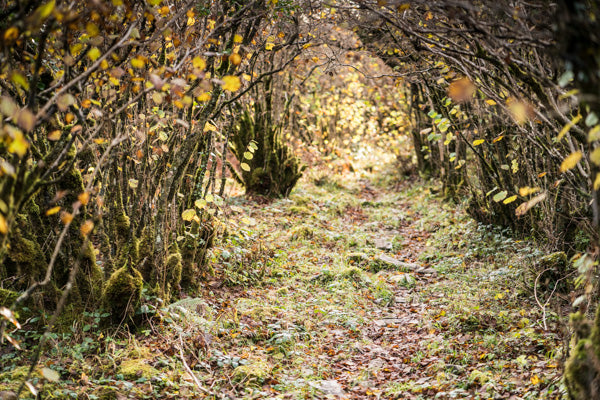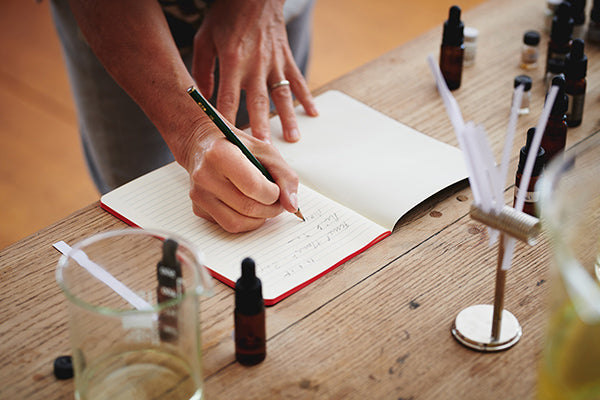When I give perfume talks at the Perfumery, I often get asked how a perfume is created. At the moment I am working on a new perfume that will launch in 2019, so I will tell you about that journey.
The process of creating a new perfume starts a long time before the finished bottle ends up on a shelf. It is a slow unravelling of inspiration that only emerges into a finished perfume some years later. I start with an idea, an inspiration; something like a mental picture, but in smells. This can come gradually or all at once in a flash. As I am out for my morning run with Lana (our labrador) I might notice the smell of a particular flower and that will set me thinking. There could be a specific plant that I’m working around, or it could be a more general feeling or mood, for example the crisp smell of a cold Autumn morning or the mossy smells of walking through the Burren woodland.

To illustrate how a perfume is created, I often use the metaphor of music. A perfume is an expression of a mood, an experience, but also a collection of different notes, different smells, different raw materials, that are organised into a harmony. Imagine the notes in a piece of music which create a tune when played together in the right order. All the many possibilities! The feeling or mood created by those notes depends critically on how they are arranged, combined, repeated, etc. If I want to move the mood in a particular direction, what ingredient should I add to make that happen?
The ingredients, the raw materials, in a perfume are organised in an olfactory pyramid. Top notes are those notes that you smell when you first spray the perfume. They are more volatile (short lived) by nature and they last up to an hour on the skin. All citrus notes are top notes. You could think of them as your first introduction to a perfume. As with an introduction to a person, you notice the immediate features first: the visual, the striking.
Then we move to the middle notes, which are the heart of the perfume, the ones that give it its character. All the aromatics, such as lavender, are middle notes, as are many florals, such as rose. These can last up to 4 hours on the skin for natural perfumes. As if you’ve met someone, and now you’ve spent time in their company, talked to them. You’re going past the visual and beginning to know their character, who they are, what they like or dislike. Your initial impressions may have been quite changed while you talked.

At the next level we have base notes. These are the ingredients that ground a perfume and fix it. They hold the olfactive pyramid together and allow the upper notes to be placed on top. Think of the bass line in a piece of music: you wouldn’t listen to it on its own but without it, the composition wouldn’t have the same depth. These are the ones that you can still smell on your skin that evening or even the next morning. In our analogy, this is the sense of a person that stays with you after you’ve parted company. They’re ‘warm’ or ‘spirited’; ‘grounded’, ‘lively’, etc.
The first in my new series of perfumes is inspired by one of my favourite natural scents in the Burren, the very delicate perfume of wild rose, Rose Burnet, subtle, fresh, feminine and floral. I will marry that with the green notes of fresh geranium leaves to bring a clear, light touch to the perfume. If you were to think of it in colour it would be a soft fresh pink and a splash of tender citrus green.
Now that I’m clear about what I’m trying to create, I jot down a formula, which is really a first attempt at recording what ingredients I will need to bring together and in what proportions. I will be using lots of other plant oils as well as the Wild Rose to create a fully balanced experience. My finished perfume will contain about 50 different natural ingredients. I enjoy the amazing richness of natural raw materials, the unending possibilities and combinations and the challenge of working with such complex ingredients.

Next, the practical work begins. I start work measuring out very small quantities of the raw materials, literally drops, into a 10ml bottle. I will make a number of different variations or trials around the central theme, and then smell them to see how I feel about each blend, in terms of how it reflects or approaches my original intent. I log all the changes carefully. When you add two or more ingredients together, especially naturals, you never know exactly what you will get. It can be a wonderful surprise or a disappointment so this is both an exciting and frustrating part of the process.
Exciting because this is where the perfume begins to have its own life and it can surprise you, take you in directions you hadn’t foreseen. Often authors will note that as they write a novel, the characters can take over and start to do things, or have feelings that their creator hadn’t envisaged in the plot. Similarly I might find that some combination of ingredients brings the fragrance to a place I didn’t expect, but which piques my interest.
The frustrating side is that sometime I expect one result and get something very different! Or I’m trying to create a particular resonance between one element and another but can’t make it happen. This phase also typically takes a long time. Blends need to be allowed to mature to see how they evolve. And it doesn’t stop at one set of trials. From the initial set I will take the most promising and refine them through another round of tests. And then do that again. Sometimes one has to stop and leave the whole process alone for a few weeks and then come back with a fresh nose if you like. Sometimes you just can’t get where you want to go from that starting formula and you have to begin all over. This phase will generally take at least a year.
Whilst the perfume itself is key, the perfume bottle and packaging is also important to our experience and enjoyment. When I first started working with perfumes, I worked for years with an immensely talented and experienced french perfume designer, Magali Sénéquier, and she taught me a lot about the art of perfume packaging. I spend a lot (a lot!) of time working on the design and feel of the bottle, cap and box. I look for a bottle that is pleasant to hold in the hand, that is simple and elegant. I like a perfume bottle to be a thing of beauty in itself so our bottles are engraved in the South of France by a historic specialist company. Our minimum order quantities are 10,000 pieces per design and we have to order them 6 months ahead of time. Caps, collars and pumps must also be chosen, tested and ordered.

We design our perfume boxes together with our fantastic designer, Doris, Creative Director of Moodley Brand Identity in Austria, and I like them to reflect the quality of the ingredients and the care that we take with the hand made production. Doris developed an entire new look for our products with us in our recent re-design which visually unified our perfume products with our skincare range, and introduced a richer colour palette in which we echoed the colours in the plants and landscape around us. Working with Doris I look at beautiful papers from Italian manufacturer Fedrigoni for our boxes, or we compare 10 different examples of enamelling for a single colour on one perfume bottle. When we print our boxes I literally stand beside the huge printing machine and colour-proof the initial sheets as they come off the printer to make sure they exactly match the artwork.
One of the privileges and pluses of being a very small private niche perfume company in a very big industry, is that we can make products that we like; we’re not trying to make millions of units of products that maximise profits for our shareholders. We can actually choose to use Italian paper in our boxes even though it’s four or five times the price of normal board, but you can feel and see the difference when you handle it. And that, for me, is essential: if we work hard to create the best fragrance we can, everything around it should be as beautiful as we can make it too. And beyond the packaging, the Perfumery itself needs to be as nice an experience for our customers and our staff as we can make it. The gardens need to be nice, the Tearooms needs to serve great food, and, perhaps most importantly, the atmosphere of the whole place needs to be calm and peaceful, with a feeling of time and spaciousness that we are often lacking in our busy lives.

Well, just as new perfume trials sometimes go in unexpected directions, this article has wandered off to a place I didn’t foresee! But there is a circularity or a closure here that makes sense now I see it written. The atmosphere and surroundings of the Burren; the wildness, the plants, the colours, the weather - is a central inspiration in what we do here. In the Perfumery itself, we try to harmonise with our surroundings, to maintain the sense of spaciousness, calm and natural vitality. Then within that workplace, we create fragrances that are echoes or perhaps facets of that wider experience. And finally, you the customer takes away a little memory of that, by hand, packaged as beautifully as we can, and hopefully a little echo of the Burren’s beauty travels home with you to some faraway part of the world.
I can’t wait for my new wild rose and green leaf perfume to launch in a few months time and see how you all like it!
